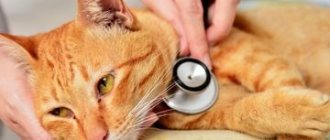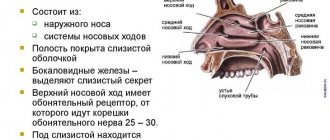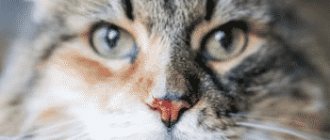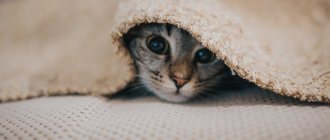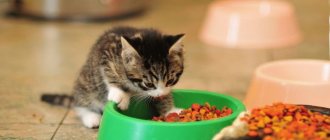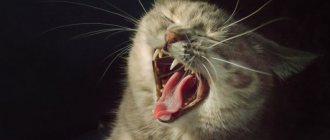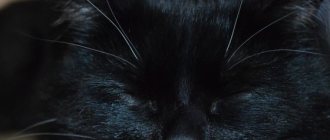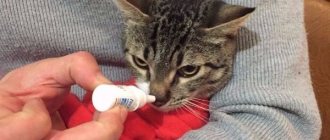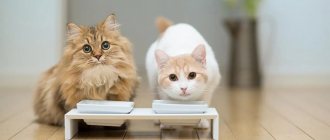Even people who have never had pets know very well that a cool, moist nose is an indicator of the health of the animal. The desire of cat owners to understand whether they should be concerned if the olfactory organ is warm and dry is understandable. Many diseases are accompanied by an increase in body temperature, at which this phenomenon occurs. But even a completely healthy cat can have a dry and warm nose. You need to be able to distinguish the symptoms of the disease from natural, safe changes in the temperature of the olfactory organ. This will help you take effective measures in a timely manner and avoid unnecessary concerns.
A cat's nose as an indicator of well-being
The main function of a cat's nose is olfactory. Thanks to numerous (almost 20 times more than in humans) receptors, it helps completely blind kittens to freely navigate in space from birth. Babies deprived of sight and hearing always find their mother by reacting to surrounding smells.
The nasal sinuses are separated by a cartilaginous septum, and immediately behind them are the ethmoidal conchae. All odors entering this section are transmitted by receptors directly to the brain, which identifies the sniffed object or subject. The nasal bones of flat-faced breeds are deformed, making it more difficult for them to recognize odors and have a harder time breathing.
In addition to the olfactory, it is important to note the protective and tactile functions. The inhaled air is filtered inside the sinuses to remove dust and microorganisms and warms up to a comfortable temperature. The tactile function is performed by the lobe. This is what cats use to determine the temperature of food.
For the owner of a mustachioed pet, the latest function remains important, allowing you to assess your well-being without undergoing tests. If the animal is healthy, then its lobe:
- a little shiny;
- cool;
- wet;
- has no crusts or scales.
Humidity is achieved thanks to a special secretion secreted by the mucous membranes. It creates a protective film that protects the cat from the adverse effects of external factors, and helps to retain molecules of foreign substances to recognize their odors. Also, the wetness of the nose is associated with frequent licking, characteristic of the cat family.
The cat has a cold and dry nose: what to do?
When a cat's nose is cold and dry, this is also a bad sign. This may happen for the following reasons:
- The cat has severe intoxication, regardless of its origin.
- During sepsis.
- If your pet is experiencing the thermal stage of some infectious disease.
- During intermittent fever. In this case, the animal’s temperature can periodically rise and then decrease.
- In each case, the nose becomes cold, as does the body of the animal. Most often, an unexpected drop in body temperature indicates that the animal’s brain does not have time to respond to thermoregulation.
Cold
- Sometimes this condition leads to the death of the pet. Immediately place the cat in a warm room (just make sure the room is not too hot), and call a veterinarian immediately. Self-treatment in such a situation can lead to big problems.
Why is my nose dry and warm?
A warm nose in cats is explained by an increase in body temperature (hyperthermia) and blood pressure. Such changes are not always explained by diseases - they can be the result of physiological processes.
Norm
Lack of moisture in kittens is associated with inability to maintain hygiene. Babies who do not know how to lick themselves completely rely on their mother cat. If separated from the mother too early, the owner will have to take care of the nose. Without timely moisturizing, it can crack, causing severe discomfort to the small pet.
If the usual activity and appetite are maintained, the cause of a hot nose in a cat may be:
- High activity
. Increased metabolism, necessary for muscle function, contributes to a rise in temperature and loss of fluid.
- Long sleep
. During rest, all internal processes slow down. The work of the mucous glands is no exception. The usual humidity returns some time after waking up.
- Dryness and high indoor temperature
. Under such conditions, the rate of moisture evaporation exceeds the rate of secretion production. That is why it is recommended to keep animals away from heating appliances. A humidifier can also help solve this problem.
- Low fluid intake
. Make sure your pet drinks its daily intake. Lack of water can lead to dehydration.
- Stress
. An animal's excitement is accompanied by behavioral changes: aggression, unsociability. When under stress, the cat will avoid communication and lick itself frequently. Knowing the cause of his worries, you need to try to eliminate it or use sedatives recommended by the veterinarian.
- Estrus
. This period is easy to recognize by loud songs, excessive affection and a characteristic posture.
Measuring body temperature using the lobe is not always accurate, since the owner is guided by his own feelings. If the pet’s condition does not return to normal, take a measurement with a rectal thermometer.
Dangerous reasons
If none of the physiological reasons are suitable, then a hot nose in a cat may indicate the presence of an illness. It can be identified by accompanying symptoms, but only a doctor can make an accurate diagnosis.
Diseases accompanied by hyperthermia include:
- neoplasms and foreign bodies stuck in the sinuses;
- injuries that prevent secretion production;
- diseases of the urinary system;
- rhinitis and sinusitis;
- inflammation and infections;
- trichobezoars that have clogged the stomach or intestines;
- helminthiases;
- poisoning and gastrointestinal disorders associated with overeating;
- tick infestations.
If you suspect any of the listed pathologies, it is recommended to immediately contact a veterinary clinic. The sooner the cause of the illness is detected, the less likely complications will arise.
Causes of dry nose
During sleep or within 30-40 minutes after the pet wakes up, his nose is dry, this is the norm, because when a cat sleeps, its nose is not moisturized.
The mucous membranes do not work properly in hot weather, in dry air, when the room is poorly ventilated, or when the pet stays near heating appliances for a long time. A kitten has a dry nose because the kitten cannot lick it himself, and because of his age, secretion is not yet produced. During active play, a cat's temperature rises. A pet's inactivity can also cause a dry nose or due to stress.
A cat's dry nose after giving birth is a natural reaction of the body to lambing. A pregnant woman's temperature may rise slightly because her metabolism accelerates, while a nursing cat's nose dries out quickly. After castration and sterilization, animals have a slightly elevated temperature, this is the body’s reaction to surgical intervention. Older Thai cats have a dry nose, this is considered normal for this breed.
If your pet has a dry nose, it is recommended to monitor it and, if necessary, measure its temperature.
But it is still recommended to carefully observe the pet during the day and check the humidity of its nose, and if necessary, measure the temperature. The normal temperature for cats is 38-39 °C, for Bengal and exotic kittens it is 39-40 °C, and for pregnant cats it is 0.5 °C higher, if above these values it is worth contacting a veterinarian.
Related signs and their meaning
You can guess why a cat has a dry and warm nose based on the accompanying signs. If at least one of them indicates a pathology, then the pet needs to be shown to a veterinarian.
Loss of appetite
Deterioration of appetite is typical for a weakened body. With infection, inflammation and disease of internal organs, refusal to eat is accompanied by apathy, increased sleep duration and a rise in temperature.
If the measurement with a thermometer does not show the presence of a deviation, analyze recent events. Some of them could cause severe stress. In this case, the problem can be dealt with with the increased attention and affection that the pet needs.
Hot ears
A kitten's warm nose combined with hot ears indicates hyperthermia. It occurs when:
- infection with ear mites, accompanied by an unpleasant odor from the ears;
- colds and ear infections (otitis);
- presence of injuries and hematomas;
- viral infections;
- stress;
- prolonged stay in a warm and stuffy room.
Physiological causes can be easily eliminated on your own. If the matter lies in pathology, then it is better to seek help.
Unusual nose color
Another cause for concern is any discoloration. Blueness is characteristic of intoxication, yellowness is characteristic of kidney failure, increased redness is characteristic of a burn, and unnatural pallor is characteristic of heart pathologies.
Painful symptoms
With damage to the gastrointestinal tract and most viral infections, the animal will experience vomiting and diarrhea. Much can be said by the appearance of vomit and feces. If blood appears, your pet must be hospitalized immediately, as such a symptom indicates the presence of internal injuries.
In addition to changing the color of the mucous membranes of the nose, it is important to consider the nature of the discharge. Discharge from the nasal sinuses can be clear, serous and purulent. A cold causes sneezing, red eyes, and breathing problems. Parasite infestation is often accompanied by hair loss and deterioration in hair quality.
Difficulty breathing, anemia, sudden weight loss, seizures and paralysis are characteristic of malignant neoplasms. If you notice an unsteady gait and excessive drooling, you should immediately contact a veterinary clinic. These symptoms indicate damage to the nervous system and can lead to very sad consequences.
Pathological causes of fever in a cat
A pet's dry, hot nose for several hours may indicate illness. It is necessary to carefully examine the animal to try to determine the cause of the illness.
Examination of mucous membranes
Changing the color of the nasal mirror, like other mucous membranes, can help in determining the area of pathology. It occurs in the following cases:
- increased pallor appears with hypothermia and poisoning, and it also appears with anemia - a lack of hemoglobin in the blood;
- cyanosis of the skin and mucous membranes occurs when there is a lack of oxygen in the tissues, which may indicate a malfunction of the cardiovascular system;
- a reddish tint to the nose indicates an infectious disease, including rhinitis, and this color is also possible with high blood pressure, allergies or injury;
- a yellowish color appears in case of liver problems.
Diagnosis of changes in the color of mucous membranes is easy to carry out if the nose mirror is light, and black cats will have to examine the inside surface of the mouth.
The pale mucous membrane of the oral cavity may look like this
By examining the mucous membrane of the mouth, you can check the functioning of the circulatory system. To do this, you need to press on the surface and then release. The white spot that appears when pressed should disappear within 2 - 3 s. If this does not happen, there are problems in its functioning.
Pulse detection
Pulse is an essential indicator of health status. To calculate it, you need a stopwatch or a watch with a second hand. In cats, the pulse is best felt in the femoral artery, which is located on the inside of the limb. To find it, you can follow the suggested instructions:
- lightly press with your fingers at the point where the artery passes to feel the pulsation of the blood flow;
- note the time on the stopwatch, and within 10 s. count blood pulses;
- multiply the resulting result by 6, this will be the pulse rate - the number of beats per minute.
A cat's normal heart rate is between 120 and 140 beats/min. But in large breeds of cats it is a little slower, and in small kittens it can reach 190 beats per minute.
Hand position when determining a cat's pulse
The pulse changes in the following cases:
- with an increase in body temperature, emotional arousal, during the period of searching for a mate, the pulse increases;
- inflammation of the heart muscle (myocarditis) can cause both a slower and faster heart rate;
- Poisoning at the initial stage causes a strong heartbeat, and then the pulse drops below normal.
Temperature detection
An important indicator of a cat's health is body temperature. The most reliable indicators include the rectal method of measuring it (in the anus). An ordinary thermometer is suitable as a measuring device, but the duration of the procedure depends on its type:
- 6 minutes is required when using a mercury thermometer;
- 3 min - for its universal electronic analogue;
- 10 s - when using special rectal thermometers.
An electronic thermometer is also safer, since there is always the possibility of damage to the mercury flask and poisoning by its contents.
How to measure a cat's temperature
It is better to carry out the measurement procedure with an assistant to make it easier to hold the animal:
- prepare the thermometer by lubricating its tip with Vaseline or another emollient;
- secure the cat on a hard surface (or wrap it in a towel and hold it under your arm);
- the thermometer is slowly inserted into the anus about 2.5 cm;
- performing calming movements, you need to keep the cat in a motionless position for the required period of time;
- evaluate the measurement result, disinfect the thermometer and place it in your pet’s first aid kit.
The normal temperature of a healthy cat is 38.5°C. The following indicators are dangerous:
- below 37.8°C - such indicators can be due to hypothermia, problems with the endocrine system or bleeding;
- 39.2 - 39.5°C - high temperature, indicating the presence of pathology;
- over 41°C - a state of heat stroke, you must urgently contact a veterinarian and take measures to reduce the temperature before the doctor arrives: place the animal in a cool place;
- provide a flow of fresh air;
- apply ice;
- wash with cold water or, as a last resort, immerse the pet in it completely.
The opposite problem is that the nose is too wet.
Although wetness is the recommended condition for a cat's nose, in some situations it can indicate pathology. Such exceptions include:
- Cold
. Due to a runny nose and frequent sneezing, the earlobe does not have time to dry out.
- Allergy
. The number of discharges correlates with colds. The only difference is that the symptoms disappear soon after the allergen is eliminated.
- Tumors, polyps and foreign objects
. Trying to get rid of the obstacle, the body produces an increased amount of mucus. If internal damage occurs, the discharge may contain blood or pus.
- Hypothermia or poisoning
. In addition to mucosal sputum, a decrease in temperature is noted.
- Infections
. Hot ears and copious discharge from the sinuses are characteristic of rhinotracheitis and panleukopenia.
- Cardiovascular diseases
. The appearance of increased humidity is accompanied by blanching of the mucous membrane.
This variety of possible interpretations confirms the danger of self-medication. An incorrect diagnosis can lead to aggravation of the real problem and deterioration of the animal's condition.
Cat treatment
If your furry dog has a dry nose, you should not give him Aspirin, Paracetamol, or Nimesulide. Such drugs can lead to the death of the animal.
For dermatitis, you need to wash the wounds with a solution of Furacilin or Chlorhexidine, but you cannot use hydrogen peroxide, it will cause burns. Allergic reactions accompanied by dry nose are treated with premium hypoallergenic food. If the cat is lethargic, the temperature rises, which means there is an inflammatory process, treatment is carried out with antibiotics prescribed by the doctor. They often give weak Amoxicillin 1/8 tablet. It is recommended to treat intestinal disorders, gases and urinary diseases with the help of diet therapy; there are special foods for this. And what you need to do if your pet is sick and has a dry nose is to follow all the veterinarian’s instructions.
What to do if a disease is suspected
If you have hyperthermia, you can try to lower the temperature a little with improvised means. To do this, you need to ventilate the room, wet the fur with water, and apply cold compresses to the pet’s armpits.
Stay hydrated. If you refuse water, give your pet food through a pipette or syringe. Crusts that appear on the lobe can be soaked with chlorhexidine or furatsilin. If these actions do not help, and the animal develops painful symptoms, contact a veterinary clinic for help.
Remember that cats should not be given antipyretics unless prescribed. Most human drugs are toxic to them and can cause severe poisoning or an allergic reaction.
After the examination, the doctor will tell you what to do if your cat has a dry nose, based on the results obtained. If there is a threat to the life of the mustachioed patient, he will be left in the hospital until his condition normalizes.
Don't panic at the sight of a dry cat's nose. If it is detected, monitor your pet and its accompanying symptoms. If playfulness and good appetite have not disappeared, then relax and analyze the situation. Physiological reasons are easy to determine on your own, so just remember them to avoid unnecessary worry in the future.
The article is for informational purposes only. Contact your veterinarian!
What and how to help your pet? Some useful tips for owners
We figured out why the kitten has a dry nose. What should the owner do to help the pet?
First, observe your pet during the day and check its temperature. If he is inactive and has no appetite, then this is really a reason to see a doctor.
In addition to a wet nose, the animal may have hot ears. This symptom is also a sign of illness. Therefore, you should check the temperature. This is usually done rectally. The normal temperature in a cat is on average 38.5, but in kittens it can be half a degree higher. If the temperature is higher, then it is possible that your pet is sick.
What measures should be taken
If you treat your pet carefully, the owner can easily determine the cause. To exclude inflammation or neoplasms, it is recommended to regularly conduct self-examination at home. The condition of the oral cavity is also studied.
If you experience severe discomfort and other negative symptoms, you should immediately seek professional help.
Only a competent veterinarian will be able to accurately determine the cause of the changes and select effective treatment.
A diagnostic examination is prescribed, including palpation, auscultation, general blood test, biochemistry, and serological testing if infection is suspected.
Giving your cat antipyretic drugs on your own is strictly prohibited. An incorrectly selected dosage can cause a deterioration in health and lead to complications.
What can a cat's nose tell you?
The skin of a cat's nose is covered with glandular secretion, which serves to retain molecules of odorous substances and protect the earlobe from drying out. As the liquid contained in the secretions of the glands evaporates, it cools the skin, so the nose of a healthy cat is cool and slightly slippery to the touch. The nose is considered to be an indicator of a cat's health. Veterinarians call it the nasal planum, since it reacts quite clearly to the fluid deficiency that has formed in the cat, especially in cases where it is provoked by overheating.
How does a cat’s dry and hot nose feel and look?
A nose that is dry and hot to the touch loses its smoothness and becomes rough. The color of the nose, especially with its light pink tint, may visually become darker; the skin of the noselobe looks rougher, more dry, and if the noselobe remains dry for a long time, minor damage forms on it, since there is no protective effect of the secretion of the nasal glands.
A cat's nose is very sensitive, and damage to it is always painful for the animal. In addition, when it dries out, the cat’s acute sense of smell, which he has always been accustomed to relying on, deteriorates, which depresses the pet and can even result in loss of appetite, since the animal does not smell food well.
A healthy cat who is sleeping or has recently woken up may have a dry and warm nose.
Question and answer: if the nose...
very cold but pale
Typically, this condition is accompanied by a lack of appetite due to poisoning, and can also be a sign of hypothermia or internal chronic pathologies, including problems with the heart. Stress and shock also cause a cat's nose to turn pale (but do not dry it out).
warm and white
The problem clearly lies in dysfunction of the hematopoietic and circulatory systems. A visit to the veterinarian is required.
hot and intense pink/red
Perhaps there has been a bruise of the nasal planum, infectious diseases are present, or there is rhinitis (both infectious and allergic in origin).
hot and very humid
When there is a transition from a dry state to a wet and cold state, the nose first becomes wet and then cools down. If this state does not last long, it means that everything is going as it should - the owners just got to the moment when it still had time to cool down. But if the condition is prolonged and the nose remains hot but wet, you need to measure your body temperature, perhaps it has increased.
blue or blue-violet plus hot
This is the first sign of oxygen starvation and/or heart failure, when an acute lack of oxygen in the tissues of the body is detected. Inflammatory processes in the lungs can also contribute to a blue nose in a cat.
dry and lethargic
Any sign that complements a dry and warm nose indicates that the pet is unhealthy. The task of the owner of a mustachioed pet is to determine the body temperature and seek the advice of a veterinarian to find out for sure what happened to the animal.
hot ears and dry nose
A classic manifestation of increased body temperature. If the ears become noticeably hot and dryness of the nasal planum is noticed, be sure to measure the temperature (rectally)!
the cat does not eat and the nose is dry
It is also a clear sign that the animal is unhealthy. The reasons range from poisoning to serious infections. A veterinarian will help you better understand the cause.
There are many reasons why the nasal planum gets warm and dries out. Not all of them are associated with any diseases. If, with such a symptom, the cat feels great, and nothing in its behavior alarms the owner, it makes sense to simply wait a while until the nose becomes wet and cold on its own. However, any of the accompanying signs of abnormal health is a clear reason to visit a veterinarian!
When a person gets sick, they always touch his forehead: isn’t it hot? In animals, this function of a sensor of well-being is performed by the nose, because they do not sweat through the skin, and heat manifests itself differently.
The respiratory system plays a significant role in thermoregulation: moisture evaporates from the nose and cooling occurs.
Cats are always looking for warmer places
